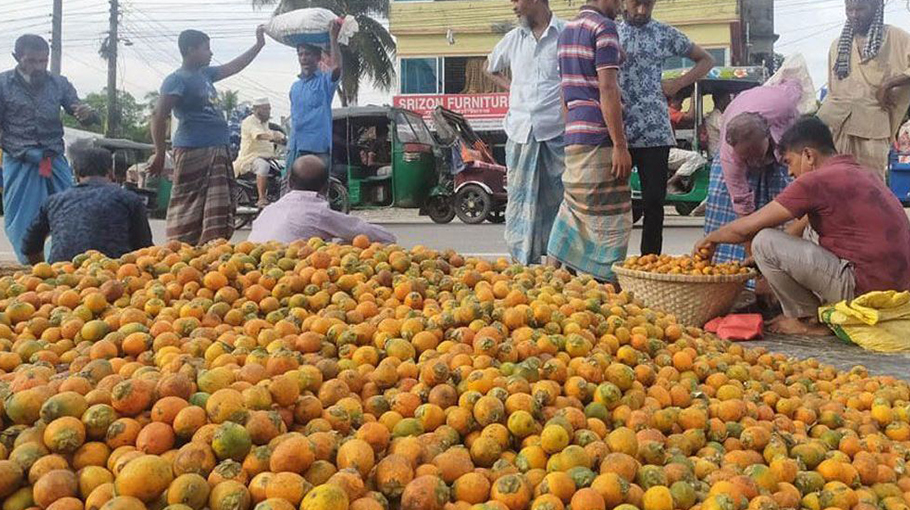Lakshmipur farmers happy with bumper betel nut production

Ramgati-Kamalnagar upazilas of Lakshmipur experienced a bumper harvest of betel nuts this year. Farmers and wholesalers are busy buying and selling betel nuts in both retail and wholesale markets.
The soil and climate here are highly conducive to betel nut cultivation, and farmers are producing betel nuts worth lakh takas through plantations. With good market prices, people's interest in betel nut farming has been increasing.
According to sources from the Department of Agricultural Extension of Ramgati and Kamalnagar upazilas, the soil and climate here are very suitable for betel nut cultivation. Through betel nut plantations, local farmers are benefitting. Due to proper care and timely attention, this year has seen a bumper crop of betel nuts in these areas. Compared to the last few years, the price of both raw and ripe betel nuts has increased slightly. Farmers are happy to receive good prices for their produce. In Kamalnagar upazila, betel nuts have been cultivated on 119 hectares of land, with a target production of 595 metric tonnes, valued Tk 14.87 crore. In Ramgati upazila, betel nuts have been cultivated on 659 hectares, with an estimated market value of Tk 24.57 crore.
Experts said, areca palm begin to flower during mid-April and to mid of May. These flowers then turn into fully ripened betel nuts by the mid of October to mid of November, which is traditionally the peak season for areca nuts. However, this year, betel nuts arrived in the market earlier than usual, starting towards the middle of October.
Now, a large quantity of betel nuts is available in every market in the upazila. Local traders soak 70 percent of the local betel nuts in the water, while the remaining 30 percent is either supplied to various districts across the country or dried under the sun for preservation. This year, farmers and small traders are pleased with the good prices for both ripe and unripe betel nuts.
Some betel nut farmers expressed concerns that due to the lack of processing centers in Ramgati and Kamalnagar upazilas of Lakshmipur, they are often deprived of fair prices.
At the beginning of this season, a good sale of betel nuts was seen in various marketplaces across Ramgati upazila, including Alexander, Ramdayal Bazaar, Bibirhat, Ramgati Bazaar, Azadnagar, Hajiganj, Banderhat, Jamidarhat, Char Sekandar, and Ashram, as well as in various markets of Kamalnagar upazila such as Hajirhat, Korunanagar, Torabganj, and Fazumiyarhat.
Traders from Dhaka, Chattogram, and other districts of the country are collecting betel nuts from local wholesalers according to their needs. This year, the price of a ‘pon’ of betel nuts (80 pieces) ranges from Tk 130 to Tk 150, while a ‘kaun’ (1280 pieces) is being sold at Tk 2,700 to Tk 3,000, which is higher than in previous years.
Betel nut farmer Humayun Kabir and Russell Sheikh from the Zamidharhat area of Ramgati upazila said that the cost of production is low. Once the tree is planted, it requires minimal care. It is more profitable than other crops, and due to high demand, they are able to get the expected prices.
Betel nut farmers Abul Khair and Ali Ahmed from the Karunagor area of Kamalnagar upazila mentioned that if the saplings are planted properly and cared for, the trees start bearing fruit in 6 to 7 years, with peak production starting in 10 to 12 years.
Ramgati Upazila Agriculture Officer Abu Said Tarek said that the low incidence of pests and diseases in betel nut gardens is leading more farmers in the region to take up betel nut cultivation. The betel nuts produced here meet local demand and are exported to various districts, including Dhaka, Chattogram, Rangpur, Mymensingh, Rajshahi, and Srimangal.
Komolnagar Upazila Agriculture Officer, Agriculturist Md Shahin Rana, said that favorable weather conditions have led to an increase in betel nut production in this region. With low production costs, farmers are making greater profits compared to other crops.
It is mentionable that betel nut farming is gradually declining
due to river erosion. As people's homes and lands are being lost to the river, there is little space left for farming.




